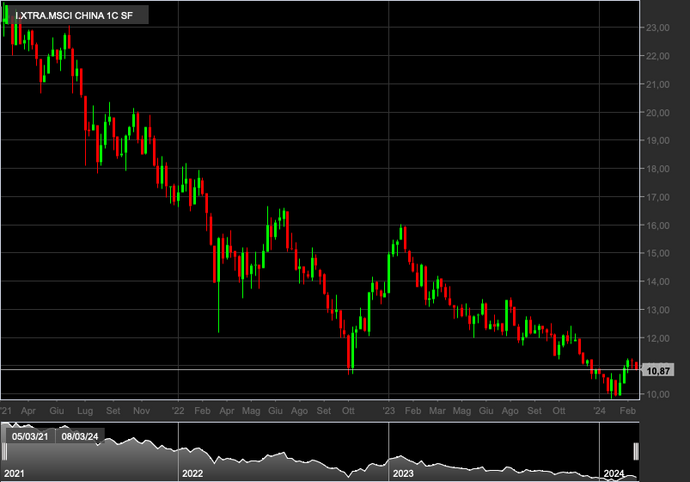The increase in short selling and capital flight from the country is negatively impacting the price of Chinese shares. Will the CSRC’s intervention help support the stock exchanges?

The Chinese stock market has been losing money for years now, and there are many reasons why.
Analysts are currently addressing the economic issues of the country, particularly the talked-about deceleration in China’s GDP growth rate and deflation. However, there is another technical aspect that is often overlooked, yet seems to have a significant negative effect on the country’s stock market: short sales. Without considering the flight by investors from investment funds that aim to offer investors exposure to the Chinese stock markets.
In short, a strong lack of trust.
Also for this reason, the CSRC has recently introduced new measures to contain this type of activity by brokers and hedge funds. Now the market does not seem to be taking a clear direction and many are wondering what the impact of these new measures could be on Chinese stock prices.
Short selling sinks Chinese stocks
Increasing bets against Chinese stocks has been a factor that has been discussed for years, not just in 2023/24. The size of short selling in China has practically tripled from 2020 to today. We are talking about an average of 100 billion Yuan since 2020, the year in which the amount of short selling started to become heavy.
But how much impact do these operations have on the Chinese stock market? answering this question provides a very interesting interpretation. As early as September 2023, the value of short interest had risen to $2.1 billion, according to IHS Markit data. At that time, the top-selling stocks were Nio Inc (NIO), Pinduoduo Holdings (PDD) and Alibaba Group (BABA). Not surprisingly, two of these three are also among the top 10 capitalizations of active and passive funds that aim to provide complete exposure to the Chinese stock market. The sharp collapse in the price of various investment vehicles has started a flight of capital from Chinese funds. According to Reuters sources, on January 3, in December, the country’s stocks saw a net outflow of $3.8 billion.
Just take a quick look at the MSCI China chart to realize what this capital flight has meant for the price of securities.

- MSCI China 1W
- Source: Baha.com
This stock market cycle has been repeating itself for years now: Short selling - market collapse - an outflow of capital from funds - worsening of the collapse - stabilization. It is no coincidence that ETF AUM recorded a significant contraction in 2023. This is very sobering evidence.
How will the CSRC stimulus measures impact?
There are many stimulus measures implemented by the Beijing government and the People’s Bank of China (PBOC) to revive the Chinese economy.
One of the most discussed measures in recent times is the cut in short selling proposed by the China Securities Regulatory Commission (CSRC). The "watchdog" of the Chinese market has been firm in its statements: zero tolerance towards malicious short sellers, "they will rot in prison".
And that’s why it appears to be moving toward completely suspending the lending of restricted shares on mainland China stock exchanges.
Who does this measure appear to be aimed at? the Chinese regulator’s attention shifts towards Brokers and Hedge funds, with the presumable aim of curbing the problem at the source.
What impact might these restrictions have on China stock prices?
Following the first restrictions, in January and the first half of February, Chinese stock markets reacted negative. In January, the MSCI China posted a loss of around 8%. In February, however, it initially showed a contraction of almost 2%, before closing the month with an increase of around 8%.
While the restriction on short selling is good news for buyers of Chinese stocks, the CSRC’s decision was very drastic and may initially appear to be a "desperate" attempt to curb falls. This has often spooked stocks in the past, initially resulting in seemingly unjustified dumps.
In China, however, the bullish faction seems to prevail: after the first drops, the stock markets have started to discount this news in the price.
This is also because, even on a practical level, the CSRC’s measures have already given tangible results. Not surprisingly, efforts to curb short selling resulted in a 24% drop in securities lending activity, for a value of 63.7 billion yuan.
In conclusion, what is happening to the Chinese stock market?
Short selling was one of the main reasons for the deep collapse of the Chinese stock market. Or rather, they amplified the collapse, leading to a flight of investors from the country’s stock sector. This implied a sharp decline in AUM in the funds.
The introduction by the CSRC of new limitations on short selling of Chinese shares aims precisely to overcome one of the main problems for the growth of share prices: the lack of confidence of investors.
Although the market initially reacted negatively, the first positive signs are already starting to appear. It is unclear whether the recent bullish movement in Chinese stocks will continue. However, it is a fact that the CSRC’s measures are bearing fruit.
Original article published on Money.it Italy 2024-03-05 17:36:57. Original title: I veri motivi dietro il crollo del mercato azionario cinese





